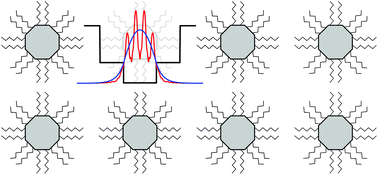The role of ligands in electron transport in nanocrystal solids†
Abstract
We investigate theoretically the transport of electrons and holes in crystalline solids consisting of three-dimensional arrays of semiconductor nanocrystals passivated by two types of organic ligands—linear chain carboxylates and functionalized aromatic cinnamates. We focus on a critical quantity in transport: the quantum-mechanical overlap of the strongly confined electron and hole wavefunctions on neighboring nanocrystals. Using results from density-functional-theory (DFT) calculations, we construct a one-dimensional model system whose analytic wavefunctions reproduce the full DFT numerical overlap values. By investigating the analytic behavior of this model, we reveal several important features of electron transport. The most significant is that the wavefunction overlap decays exponentially with ligand length, with a characteristic decay length that depends primarily on properties of the ligand and is almost independent of the size and type of nanocrystal. Functionalization of the ligands can also affect the overlap by changing the height of the tunneling barrier. The physically transparent analytic expressions we obtain for the wavefunction overlap and its decay length should be useful for future efforts to control transport in nanocrystal solids.

- This article is part of the themed collection: 2020 Nanoscale HOT Article Collection


 Please wait while we load your content...
Please wait while we load your content...
